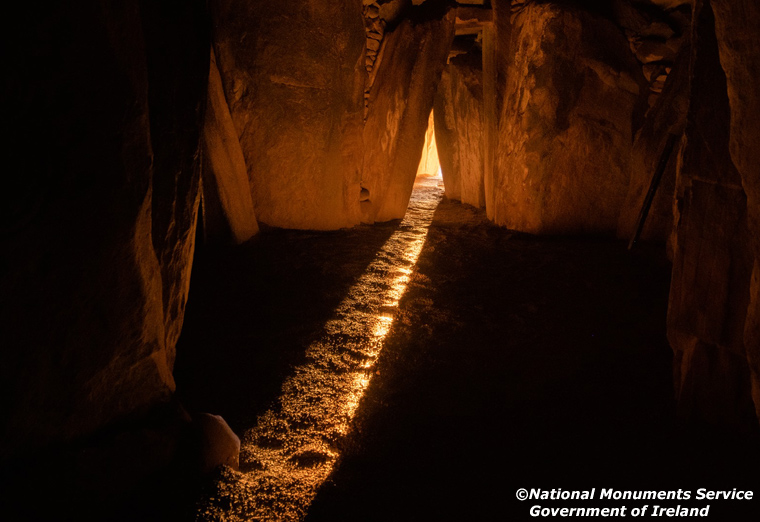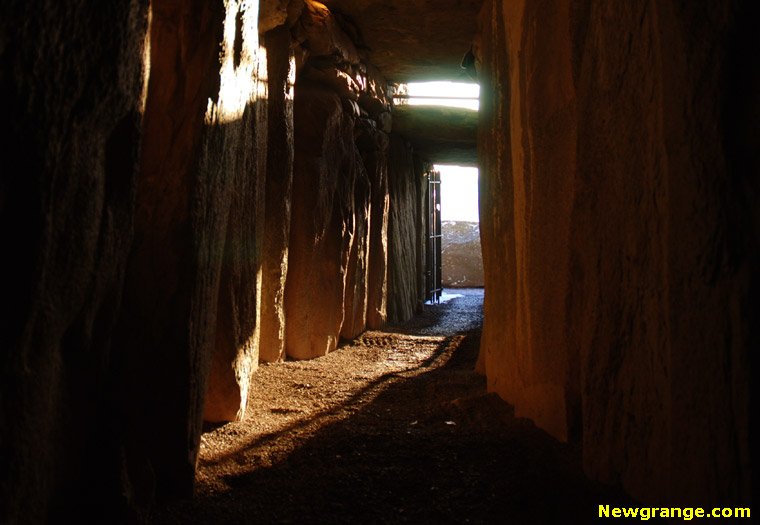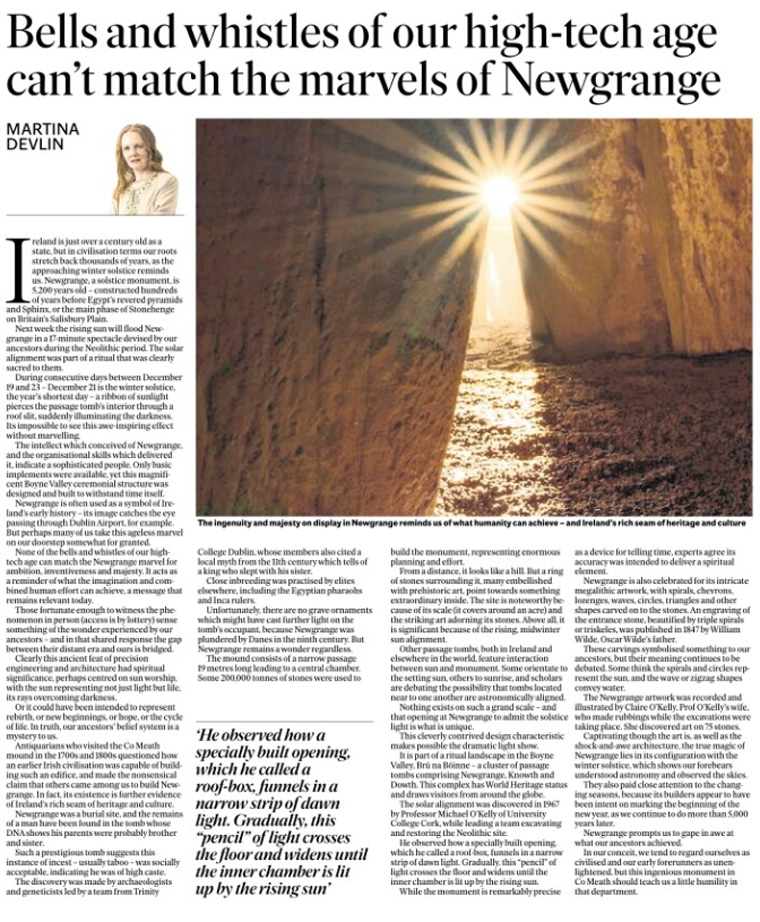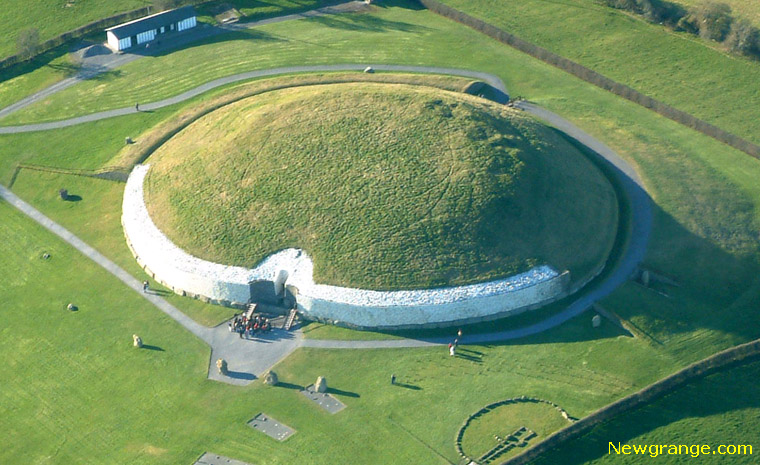Our high-tech age can't match the marvels of Newgrange
Bells and whistles of our high-tech age can't match the marvels of Newgrange in Ireland.Irish Independent - 15 December 2023 by Martina Devlin
Ireland is just over a century old as a state, but in civilisation terms our roots stretch back thousands of years, as the approaching winter solstice reminds us. Newgrange, a solstice monument, is 5,200 years old - constructed hundreds of years before Egypt's revered pyramids and Sphinx, or the main phase of Stonehenge on Britain's Salisbury Plain.
Next week the rising sun will flood Newgrange in a 17-minute spectacle devised by our ancestors during the Neolithic period. The solar alignment was part of a ritual that was clearly sacred to them. During consecutive days between December 19 and 23 - December 21 is the winter solstice, the year's shortest day - a ribbon of sunlight pierces the passage tomb's interior through a roof slit, suddenly illuminating the darkness. It's impossible to see this awe-inspiring effect without marvelling.

Winter Solstice sun beam inside Newgrange
The intellect which conceived of Newgrange, and the organisational skills which delivered it, indicate a sophisticated people. Only basic implements were available, yet this magnificent Boyne Valley ceremonial structure was designed and built to withstand time itself.
Newgrange is often used as a symbol of Ireland's early history - its image catches the eye passing through Dublin Airport, for example. But perhaps many of us take this ageless marvel on our doorstep somewhat for granted. None of the bells and whistles of our high-tech age can match the Newgrange marvel for ambition, inventiveness and majesty. It acts as a reminder of what the imagination and combined human effort can achieve, a message that remains relevant today.
Those fortunate enough to witness the phenomenon in person (access is by lottery) sense something of the wonder experienced by our ancestors - and in that shared response the gap between their distant era and ours is bridged. Clearly this ancient feat of precision engineering and architecture had spiritual significance, perhaps centred on sun worship, with the sun representing not just light but life, its rays overcoming darkness.
Or it could have been intended to represent rebirth, or new beginnings, or hope, or the cycle of life. In truth, our ancestors' belief system is a mystery to us. Antiquarians who visited the Co. Meath mound in the 1700s and 1800s questioned how an earlier Irish civilisation was capable of building such an edifice, and made the nonsensical claim that others came among us to build Newgrange. In fact, its existence is further evidence of Ireland's rich seam of heritage and culture.

Winter Solstice sun beam in Newgrange
Newgrange was a burial site, and the remains of a man have been found in the tomb whose DNA shows his parents were probably brother and sister. Such a prestigious tomb suggests this instance of incest - usually taboo - was socially acceptable, indicating he was of high caste. The discovery was made by archaeologists and geneticists led by a team from Trinity College Dublin, whose members also cited a local myth from the 11th century which tells of a king who slept with his sister. Close inbreeding was practised by elites elsewhere, including the Egyptian pharaohs and Inca rulers. Unfortunately, there are no grave ornaments which might have cast further light on the tomb's occupant, because Newgrange was plundered by Danes in the ninth century. But Newgrange remains a wonder regardless.
The mound consists of a narrow passage 19 metres long leading to a central chamber. Some 200,000 tonnes of stones were used to build the monument, representing enormous planning and effort. From a distance, it looks like a hill. But a ring of stones surrounding it, many embellished with prehistoric art, point towards something extraordinary inside. The site is noteworthy because of its scale (it covers around an acre) and the striking art adorning its stones. Above all, it is significant because of the rising, midwinter sun alignment.
Other passage tombs, both in Ireland and elsewhere in the world, feature interaction between sun and monument. Some orientate to the setting sun, others to sunrise, and scholars are debating the possibility that tombs located near to one another are astronomically aligned. Nothing exists on such a grand scale - and that opening at Newgrange to admit the solstice light is what is unique. This cleverly contrived design characteristic makes possible the dramatic light show.
It is part of a ritual landscape in the Boyne Valley, Brú na Bóinne - a cluster of passage tombs comprising Newgrange, Knowth and Dowth. This complex has World Heritage status and draws visitors from around the globe. The solar alignment was discovered in 1967 by Professor Michael O'Kelly of University College Cork, while leading a team excavating and restoring the Neolithic site. He observed how a specially built opening, which he called a roof-box, funnels in a narrow strip of dawn light. Gradually, this "pencil" of light crosses the floor and widens until the inner chamber is lit up by the rising sun.
While the monument is remarkably precise as a device for telling time, experts agree its accuracy was intended to deliver a spiritual element. Newgrange is also celebrated for its intricate megalithic artwork, with spirals, chevrons, lozenges, waves, circles, triangles and other shapes carved on to the stones. An engraving of the entrance stone, beautified by triple spirals or triskeles, was published in 1847 by William Wilde, Oscar Wilde's father.
These carvings symbolised something to our ancestors, but their meaning continues to be debated. Some think the spirals and circles represent the sun, and the wave or zigzag shapes convey water. The Newgrange artwork was recorded and illustrated by Claire O'Kelly, Prof O'Kelly's wife, who made rubbings while the excavations were taking place. She discovered art on 75 stones. Captivating though the art is, as well as the shock-and-awe architecture, the true magic of Newgrange lies in its configuration with the winter solstice, which shows our forebears understood astronomy and observed the skies.
They also paid close attention to the changing seasons, because its builders appear to have been intent on marking the beginning of the new year, as we continue to do more than 5,000 years later. Newgrange prompts us to gape in awe at what our ancestors achieved. In our conceit, we tend to regard ourselves as civilised and our early forerunners as unenlightened, but this ingenious monument in Co. Meath should teach us a little humility in that department.

Boyne Valley Private Day Tour
 Immerse yourself in the rich heritage and culture of the Boyne Valley with our full-day private tours.
Visit Newgrange World Heritage site, explore the Hill of Slane, where Saint Patrick famously lit the Paschal fire.
Discover the Hill of Tara, the ancient seat of power for the High Kings of Ireland.
Book Now
Immerse yourself in the rich heritage and culture of the Boyne Valley with our full-day private tours.
Visit Newgrange World Heritage site, explore the Hill of Slane, where Saint Patrick famously lit the Paschal fire.
Discover the Hill of Tara, the ancient seat of power for the High Kings of Ireland.
Book Now
Home
| Visitor Centre
| Tours
| Winter Solstice
| Solstice Lottery
| Images
| Local Area
| News
| Knowth
| Dowth
| Articles
| Art
| Books
| Directions
| Accommodation
| Contact

